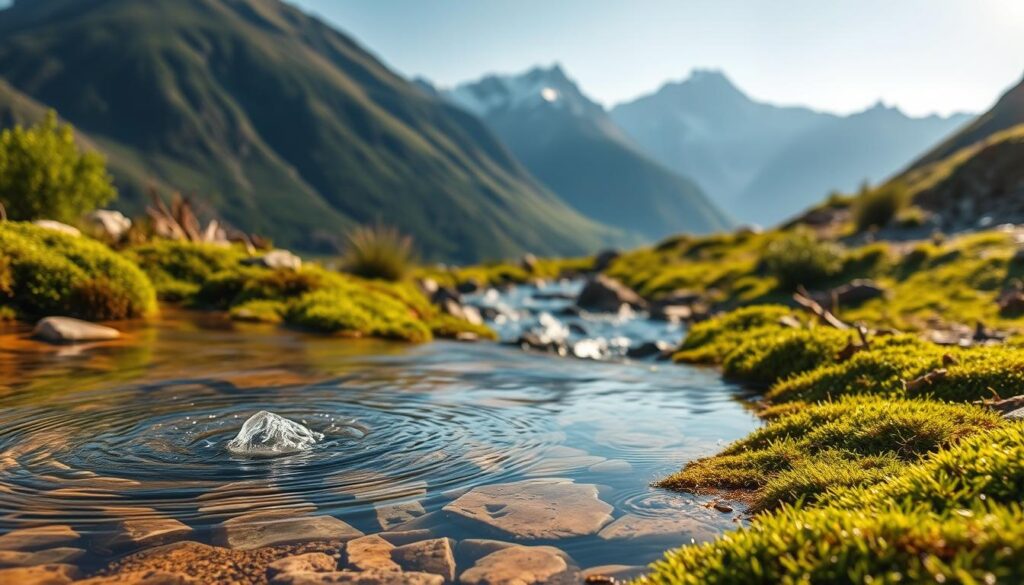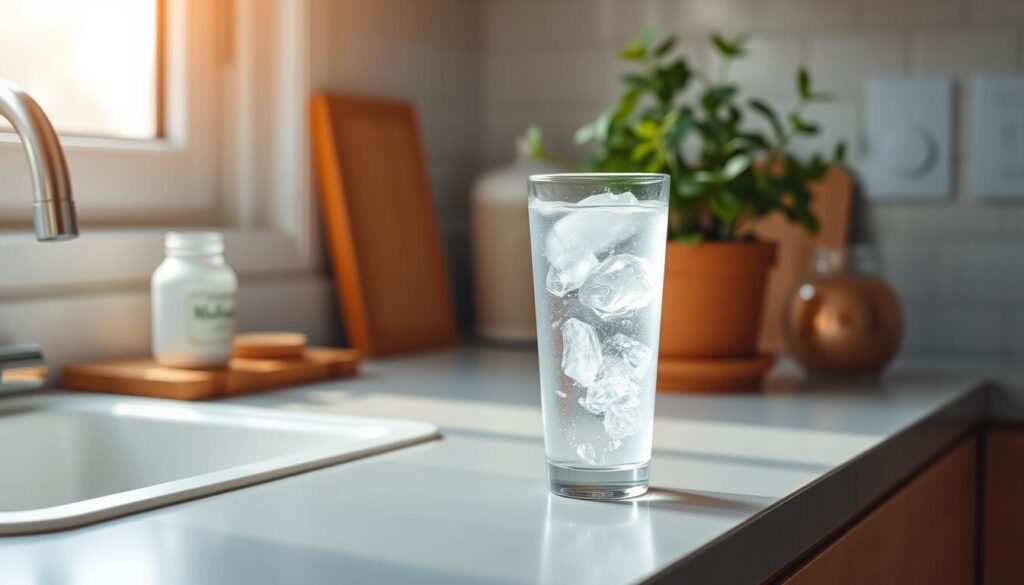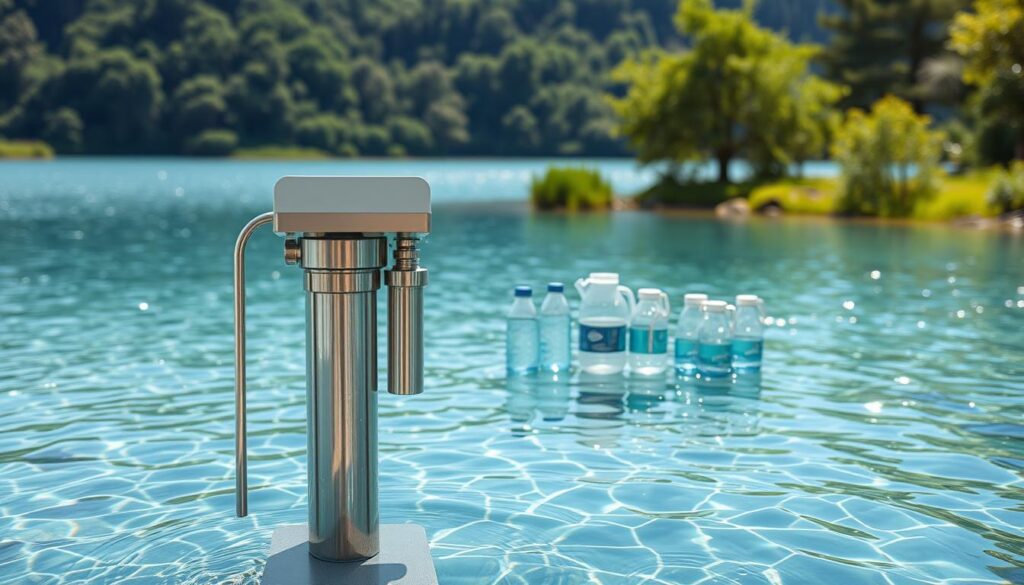Thinking about safe drinking water reminds me of its key role in our health. In the U.S., most people get their drinking water from public water systems. This is true for 9 out of 10 people.
Most tap water comes from either surface or ground water sources. It’s important to know about these sources and how to check their quality.
Finding reliable water sources is key for public health. This article will look into different potable water sources, their quality, and the rules that govern them.
Key Takeaways
- Understanding the different types of potable water sources is key for public health.
- Most tap water comes from surface or ground water.
- 9 out of 10 people in the United States get water from public water systems.
- Checking the quality of water sources is vital for safe drinking water.
- Reliable potable water sources are essential for human health.
Understanding Potable Water Sources
Finding safe drinking water starts with knowing where it comes from. Potable water is key for our health. It’s vital to understand its sources for public health.
First, let’s define potable water. Potable water is water safe for us to drink. It meets certain quality standards. This is important because it helps us judge water safety.
Definition of Potable Water
Potable water meets drinking water quality standards. These standards are set by agencies to keep water safe. Sources like rivers, lakes, and groundwater are the base of our drinking water.
A study showed many people drink groundwater. This shows how critical it is to protect and manage groundwater well.
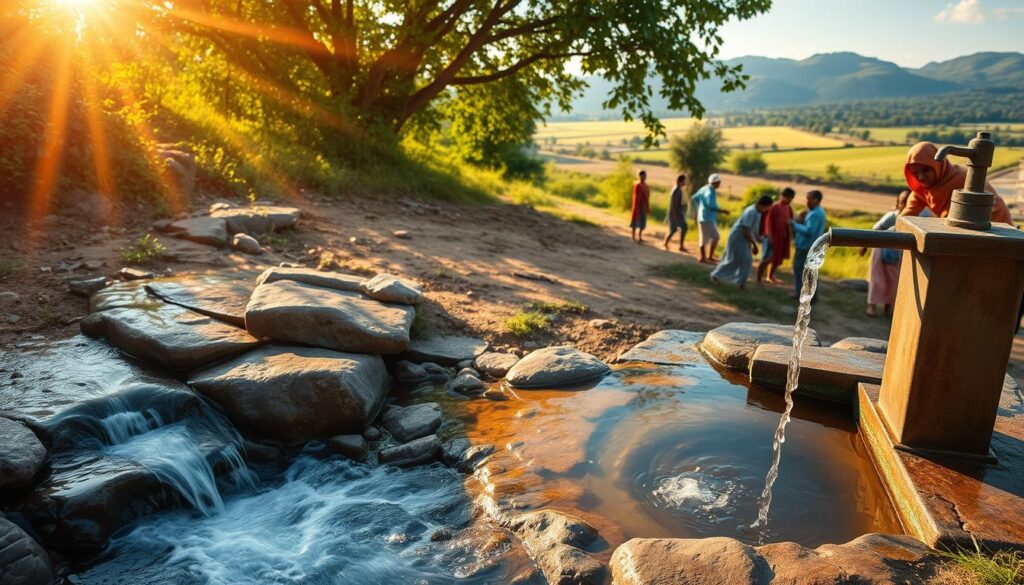
Importance of Safe Drinking Water
Safe drinking water stops waterborne diseases and keeps us healthy. The need for safe drinking water is huge. It affects our health and well-being.
| Water Source | Description | Typical Treatment Required |
|---|---|---|
| Rivers and Streams | Surface water sources that are often used for public drinking water supplies. | Coagulation, Sedimentation, Filtration, Disinfection |
| Lakes and Reservoirs | Surface water bodies that store water for drinking and other uses. | Coagulation, Sedimentation, Filtration, Disinfection |
| Groundwater | Water stored beneath the Earth’s surface, often accessed through wells. | Depends on the source; may require minimal treatment |
Knowing where our drinking water comes from is key. It helps us keep it safe and healthy. By understanding the importance of safe drinking water, we can protect it for the future.
Types of Potable Water Sources
Understanding the different types of water sources is key to getting clean drinking water. Potable water can come from various places. Knowing these can help us make better choices about water use.
Surface Water Sources
Surface water is found on the ground or in bodies like streams, rivers, lakes, and oceans. It’s often used for public water supplies because it’s easy to get and there’s a lot of it. Rivers and lakes are common examples of surface water sources that are treated and distributed for drinking.
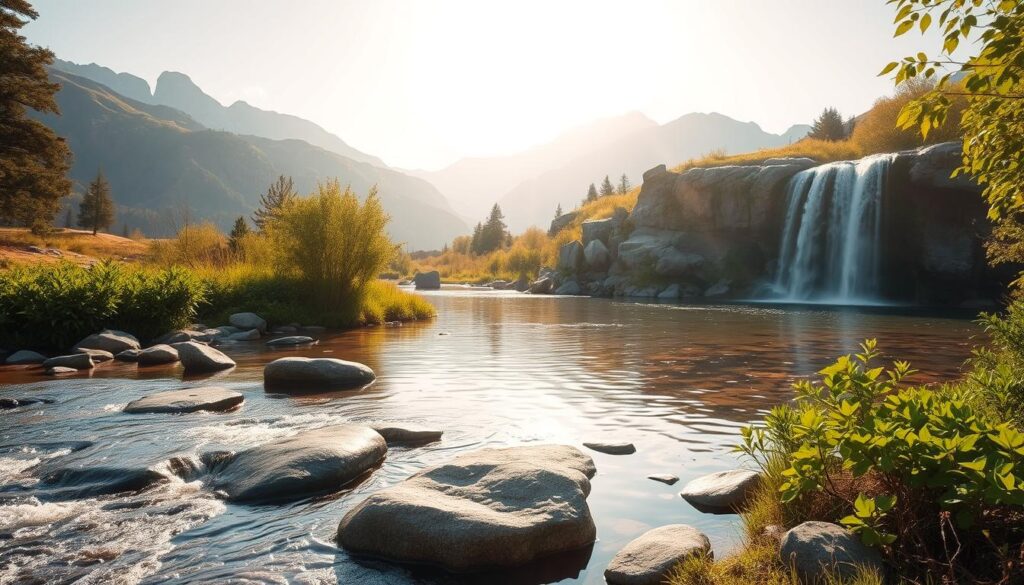
Groundwater Sources
Groundwater is under the Earth’s surface, in the spaces between rocks and soil. It’s a big source of potable water, where surface water is hard to find. Groundwater is tapped through wells and aquifers, giving many communities a steady supply of fresh water.
“Groundwater is a vital component of the global water cycle, and its sustainable management is critical for ensuring a steady supply of clean drinking water.”
Rainwater Harvesting
Rainwater collection systems are another good way to get potable water. By catching and storing rainwater, people can use less water from other sources. Rainwater harvesting is very useful in places with lots of rain.
- Rainwater harvesting reduces stormwater runoff.
- It provides an alternative source of water for non-potable and potable uses.
- Proper treatment can make rainwater safe to drink.
Assessing Water Quality
Checking water quality is key to making sure it’s safe to drink. It’s important to remove contaminants and meet health standards. This keeps everyone healthy.
Knowing what makes water good or bad is essential. Regular tests are a must, more so for private water sources. This is because we need to watch our water closely.
Key Water Quality Indicators
Several factors decide water quality. These include:
- Presence of Germs: Bacteria, viruses, and other microorganisms can cause waterborne illnesses.
- Chemical Contaminants: Chemicals from industrial processes or agricultural runoff can affect water quality.
- Physical Parameters: Turbidity, pH, and temperature are also important indicators.
For example, finding certain bacteria means the water might be contaminated. It’s vital to test for these regularly. The California Water Boards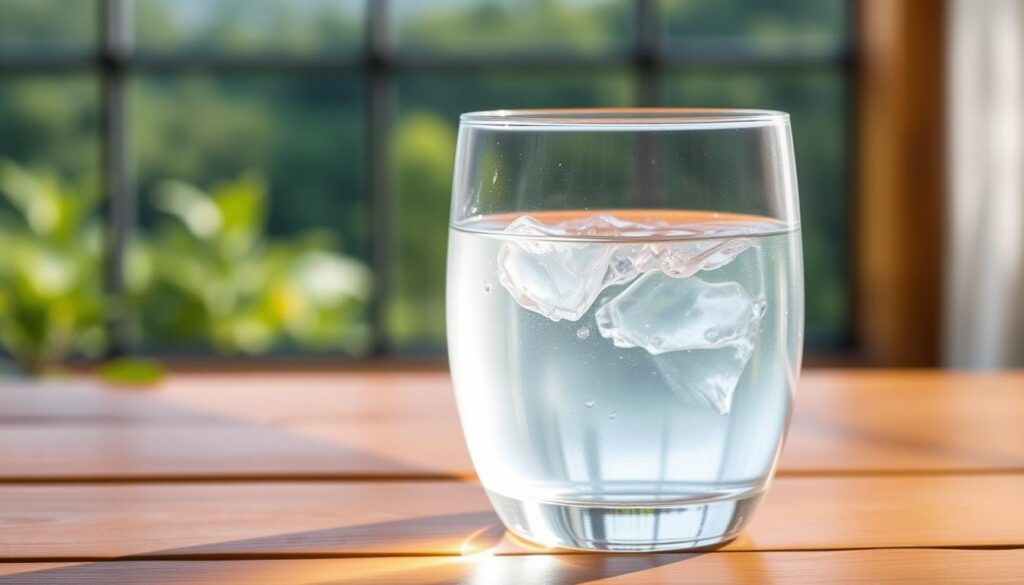
Importance of Water Testing
Testing water often is very important. This is true for private water sources like wells or rainwater. It finds contaminants early, before they harm health.
People with private water sources should test their water yearly for germs and chemicals. This keeps the water safe for drinking and use.
“The quality of drinking water is a significant concern for communities worldwide. Ensuring access to safe and clean water is a fundamental aspect of public health.”
By knowing what makes water good or bad and testing often, we can protect our health. This ensures we have a reliable potable water supply from accessible water sources.
Regional Differences in Water Sources
Access to sustainable water sources varies by region. This includes differences between urban and rural areas and geographical features. It’s key to know these differences to ensure everyone has access to clean water.
Big cities and towns usually get their water from rivers or a mix of rivers and underground water. But, small towns and rural areas mostly use underground water. This shows we need to plan water use based on each area’s needs.
Urban vs. Rural Water Sources
Urban and rural water sources differ a lot. Cities have big populations and systems to treat and move water around. But, rural areas have less access to advanced water treatment and often use wells and septic systems.
- Urban water sources include rivers, lakes, and reservoirs, managed by local water authorities.
- Rural areas often use underground water, which can get contaminated or run out.
- Water distribution systems also vary, with cities having more extensive networks than rural areas.
Impact of Geography on Water Availability
Geography greatly affects water availability. Places with lots of rain and big water bodies have more water. But, dry areas struggle to find reliable water sources.
Important geographical factors include:
- Climate: Places with lots of rain have more surface water.
- Topography: Mountains can hold water, while plains often rely on underground water.
- Geology: The type of rock and soil affects how water moves underground.
Understanding these regional differences helps communities manage their water better.
Treating Water for Potability
Treating water for drinking is a complex process. It involves many steps to remove harmful substances. After a community system gets water from a river or well, it’s treated to meet purity standards. Then, it’s piped to our homes as clean drinking water.
The treatment process is key to our water’s safety and quality. It not only removes harmful stuff but also makes the water taste and smell better.
Common Water Treatment Methods
Several methods are used to make water safe for drinking. These include:
- Filtration: This method filters out particles and contaminants.
- Disinfection: It kills harmful bacteria, viruses, and pathogens.
- Coagulation: Chemicals are added to remove dirt and particles.
These methods can be used alone or together, based on the water’s quality and contaminants.
| Treatment Method | Purpose | Effectiveness |
|---|---|---|
| Filtration | Removes particulate matter and contaminants | High |
| Disinfection | Kills bacteria, viruses, and other pathogens | Very High |
| Coagulation | Removes dirt and other suspended particles | High |
DIY Water Filtration Techniques
For quick fixes or in areas with no treated water, DIY methods can work. A simple way is to use sand, gravel, and charcoal to filter out contaminants.
But, DIY methods might not catch all contaminants. Their success depends on the materials and the water’s quality.
Knowing about water treatment methods is important for safe drinking water. Whether it’s through professional treatment or DIY, the goal is the same: to give us clean water.
Regulations Governing Potable Water
To keep drinking water safe, rules have been set by regulatory bodies. These rules are key to keeping safe water sources clean. They make sure the water people drink is safe.
These rules come from both the federal and state levels. The Environmental Protection Agency (EPA) is at the heart of setting national standards. The EPA’s National Primary Drinking Water Regulations set limits on contaminants in water. This protects public health.
Federal Regulations on Drinking Water
Federal rules aim to keep drinking water safe. The EPA sets these under the Safe Drinking Water Act (SDWA). This act helps decide what contaminants are harmful to health.
By setting these standards, the EPA makes sure water suppliers give clean water sources to everyone.
State-Specific Water Quality Standards
While federal rules are a starting point, states can set their own standards. These standards can be stricter than federal ones. This lets states deal with local issues and contaminants.
So, water quality standards can differ a lot from state to state. This shows how different the country’s water sources and environments are.
In summary, rules for safe drinking water are very important. They help ensure everyone has access to safe and clean water sources. By following these rules, water suppliers can give water that meets or goes beyond national and state standards.
Preventing Water Contamination
Stopping water contamination is a big challenge worldwide. It’s important to know how to keep reliable fresh water sources clean. Understanding what causes contamination is key.
Common Contaminants in Water Sources
Many things can make water dirty. Rivers, streams, and lakes can get polluted with livestock waste, human sewage, chemicals, and other pollutants. This can make people sick if they drink it. Fertilizers and pesticides from farms also pollute water.
These pollutants can change the taste and smell of water. They can also cause health problems. Some chemicals can lead to stomach issues or even cancer.
Best Practices for Water Protection
To keep fresh water sources safe, we need to follow best practices. Protecting the area around water sources is important. This means stopping activities that can pollute the water.
Also, controlling pollution is key. This includes rules for industrial waste and farm runoff. It helps keep the water clean.
Communities can help by using sustainable practices. This means using fewer harmful chemicals, better waste management, and teaching people about saving water.
- Implementing effective watershed management strategies
- Enforcing strict pollution controls
- Promoting public education on water conservation
Sustainable Practices for Water Use
I believe we can lessen our impact on the world’s water by using sustainable practices.
The average American uses a lot of water, mostly for food, energy, and goods. For example, the average American uses 32,911 glasses of water daily. Ninety-six percent of this is for food, energy, and other products.
Conservation Techniques for Potable Water
It’s key to save potable water for its future use. Simple steps like fixing leaks and using efficient appliances help a lot. These actions can greatly reduce water waste.
Using water recycling and efficient irrigation systems also helps. These methods can cut down water use significantly.
Collecting Rainwater Responsibly
Collecting rainwater is a smart way to manage water. It helps reduce the need for municipal water for tasks like gardening and toilet flushing.
To collect rainwater safely, it’s important to have well-designed and clean systems. For more tips on finding good water sources, check out my guide on reliable outdoor water sources.
By using these sustainable methods, we can ensure water is available for all in the future. It’s a team effort that needs both personal and community actions.
Resources for Finding Potable Water
Looking for safe drinking water? It’s key to have the right info. I can use many resources to check if local water is safe and good to drink.
Local Water Quality Reports
Local water quality reports are super helpful. They tell you where the water comes from and how it’s treated. You can get these reports from local water companies or government agencies.
Government and NGO Resources
Groups like the Environmental Protection Agency (EPA) and non-governmental organizations (NGOs) offer lots of help. The EPA has an online map to show where your water comes from. Their guide, “Water on Tap,” also helps you understand if your water is safe.
Using these resources, we can choose better drinking water. This helps keep our water safe and reliable for everyone.
FAQ
What makes water potable?
Water is safe to drink when it’s free from harmful stuff. It must meet national drinking water standards.
What are the main sources of potable water?
Main sources include rivers, lakes, wells, and rainwater. These are where we get our drinking water.
How is the quality of potable water assessed?
We test water for germs, chemicals, and other bad stuff. This checks if it’s safe to drink.
Why is water testing important for private water sources?
Testing is key for wells and rainwater systems. It keeps the water safe from sickness.
How do urban and rural areas differ in their potable water sources?
Cities use both surface and groundwater. Rural areas often rely on wells. This shows the need for different water management.
What are some common methods for treating water to make it potable?
We use filtration, disinfection, and coagulation. These methods remove bad stuff, making water safe.
What role do regulations play in ensuring potable water quality?
Rules, like those from the EPA, set quality standards. They make sure water is safe to drink.
How can water contamination be prevented?
We prevent contamination by managing watersheds and controlling pollution. This reduces risks from runoff and chemicals.
What are some sustainable practices for managing potable water sources?
Sustainable practices include saving water and using rainwater. These help manage water better.
Where can I find information on local potable water sources?
Look for local reports, check with the EPA, and visit NGOs. They offer help and advice on finding safe water.
What is the importance of reliable potable water supply?
Safe drinking water is vital for health. It stops waterborne diseases and keeps us well.
How does geography impact the availability of potable water?
Where you live affects your access to safe water. Some places face bigger challenges than others.

